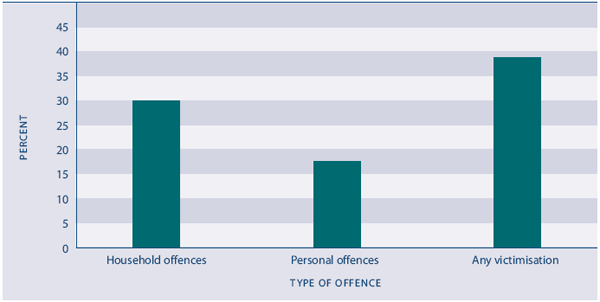Criminal victimisation
Definition
The proportion of the population aged 15 years and over who had been
victims of one or more incidents of criminal offending in 2005 as
measured by the New Zealand Crime and Safety Survey 2006.
Relevance
The criminal victimisation rate provides a broad measure of
personal safety and wellbeing. Surveys of criminal victimisation
generally provide a more comprehensive picture of victimisation than
police data, as not all offending is reported to or recorded by the
police.
Current level and trends
The survey data shows 39 percent of New Zealanders aged 15
years and over experienced some form of criminal victimisation in 2005.
Comparisons with data from earlier surveys are not possible owing to
changes in the survey design.95
Thirty percent of households had been victims of some kind of
household crime in 2005. The most common offences were burglaries (14
percent) and vandalism to household property (9 percent). Over the same
period, 18 percent of individuals had been victims of some type of
personal offence, the most common being assaults and threats (both 9
percent). A relatively small number of people accounted for the
majority of victimisations: just 6 percent of people had been
victimised five or more times during the survey period but they
experienced 51 percent of all victimisations.
Figure SS2.1 Criminal victimisation
prevalence rate, by type of victimisation, 2005

Source: Mayhew and Reilly (2007b) Table 3.1
Age and sex differences
Young people are more likely than others to be victims of
crime, and the likelihood of being victimised decreases with age. Among
people in the 15–24 years age group, 55 percent were victims of either
personal or household offences in 2005. This compares with 46 percent
of 25–39 year olds, 37 percent of 40–59 year olds and 20 percent of
those aged 60 years and over. Young people aged 15–24 years also had
the highest rates of victimisation for confrontational offences: 13
percent were victims of confrontational offences committed by partners,
10 percent were victimised by people who were well known to them, and
16 percent by other offenders.
The overall rate of victimisation did not vary by sex, with 39
percent of both men and women experiencing some form of criminal
victimisation in 2005. The pattern of victimisation by age was also
similar for both sexes. With confrontational offences, men were as
likely as women to have been victimised at least once by a partner (6
percent compared with 7 percent for women). However, women experienced
more offences than men did (26 incidents per 100 women, compared with
18 incidents per 100 men).96 Prevalence rates did not
differ by sex for offences committed by people well known to the victim
(5 percent for both men and women), but men were more likely than women
to be victims of confrontational offences by people who were not known
to them (9 percent compared with 6 percent).
Women were around twice as likely as men to be the victims of
sexual offences (4 percent compared with 2 percent), with the highest
rate experienced by women aged 15–24 years (12 percent). Over a third
of sexual offences were committed by the victims’ current partners.
Table SS2.1 Criminal victimisation
prevalence rate (%), by age and sex, 2005
| |
Rate per 100 persons in each group |
| Age group |
Men |
Women |
Total |
| 15–24 |
53 |
56 |
55 |
| 25–39 |
44 |
47 |
46 |
| 40–59 |
36 |
37 |
37 |
| 60+ |
21 |
19 |
20 |
| Total |
39 |
39 |
39 |
Source: Mayhew and Reilly (2007b) Table C3
Ethnic differences
The likelihood of being a victim of crime varies by ethnicity.
Among both Māori and Pacific peoples aged 15 years and over, 47 percent
had experienced some form of criminal victimisation in 2005. This
compared with 43 percent of Asians and 37 percent of Europeans. The
high rates for Māori and Pacific peoples are likely to be due, at least
in part, to these populations having a high incidence of other risk
factors associated with victimisation – for instance they are more
likely to be young, to be unemployed, to be sole parents and to live in
more socio-economically deprived areas.
Māori had a relatively high rate of victimisation for
confrontational offences: 14 percent for offences committed by
partners, and 11 percent both for offences committed by people well
known to them and for offences committed by other offenders. For Māori
women, the risk of being assaulted or threatened by a partner was three
times the average (18 percent compared with 6 percent for all
respondents). Comparable figures for Pacific peoples are not reliable
owing to the small size of the sample.
Other groups at risk
Other groups reporting a high level of victimisation included
sole parents with children (60 percent had experienced some form of
criminal victimisation in 2005), students and people living with
flatmates (57 percent and 54 percent, respectively), people who were
single or in de facto relationships (50 percent and 49 percent), people
who rented their homes either from private landlords or public agencies
(49 percent and 45 percent), those who were unemployed and/or on
benefits (48 percent), and those who lived in the most deprived fifth
of New Zealand areas (45 percent). Many of these characteristics are
closely inter-related. |

